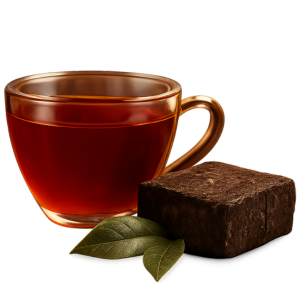
Pu-erh Tea
Caffeine
15–70 mg
Note: Caffeine amounts are based on typical brewing of loose‑leaf Pu‑erh tea and can vary significantly by type (raw vs. ripe), leaf grade, age, and brewing method. Longer steep times, hotter water, and younger raw Pu‑erh generally yield higher caffeine levels.
| Attribute | Value |
|---|---|
| Caffeine Level | Low to Moderate |
| Serving Size | 8 fl oz |
| Serving Size (ml) | 240 ml |
| Caffeine | 15–70 mg |
| Calories | 0–2 kcal |
| Sugar | 0 g |
| Caffeine per fl oz | 2–9 mg/fl oz |
Pu-erh tea is a unique fermented tea from China’s Yunnan province, prized for its earthy flavor, digestive benefits, and distinctive caffeine profile.
What is Pu-erh Tea?
Pu-erh tea is made from the leaves of the Camellia sinensis plant, just like green, black, and oolong teas. What sets it apart is its fermentation and aging process, which can last months or even decades. There are two main types: raw (sheng) and ripe (shou) 1, each with its own caffeine characteristics.
- Raw Pu-erh (Sheng) – Minimally processed, sun-dried, and aged naturally over time.
- Ripe Pu-erh (Shou) – Undergoes accelerated fermentation through a process called wo dui.
- Aging Potential – Both types can be stored for years, developing complex flavors.
- Flavor Profile – Ranges from grassy and floral (young sheng) to earthy and mellow (ripe or aged sheng).
- Cultural Heritage – Traditionally compressed into cakes or bricks for trade and storage.
This combination of processing and aging makes Pu-erh tea one of the most complex and collectible teas in the world.
How Much Caffeine is in Pu-erh Tea?
The caffeine content in Pu-erh tea can range from 15 mg to 70 mg per 8 fl oz cup, depending on the variety and preparation. Raw Pu-erh generally contains more caffeine than ripe Pu-erh, especially when young.
- Young Raw Pu-erh – 60–70 mg caffeine per cup (similar to some coffees).
- Aged Raw Pu-erh – 30–50 mg per cup.
- Ripe Pu-erh – 30–50 mg per cup, sometimes as low as 15–20 mg in very aged batches.
- Comparison to Coffee – Coffee averages 80–100 mg per 8 fl oz, so Pu-erh is generally milder.
- Comparison to Green Tea – Green tea averages 25–45 mg per cup, so some Pu-erh can be stronger.
This variability means Pu-erh can be tailored to your caffeine needs — from a gentle evening brew to a more stimulating morning cup.
Factors That Affect Caffeine Levels
Several factors influence how much caffeine ends up in your cup of Pu-erh tea. Understanding these can help you control your intake.
- Type of Pu-erh – Raw (sheng) retains more caffeine; ripe (shou) loses some during fermentation.
- Leaf Grade – Bud-heavy leaves have more caffeine than mature leaves.
- Age of Tea – Older teas often have slightly reduced caffeine.
- Brewing Time – Longer steeping extracts more caffeine.
- Water Temperature – Hotter water increases caffeine release.
- Teaware – Porous clay pots can absorb some caffeine over time.
By adjusting these factors, you can fine-tune your Pu-erh experience for taste and energy.
Health Effects of Pu-erh’s Caffeine
Pu-erh’s caffeine interacts with other compounds like theobromine and theophylline, creating a different effect than coffee’s sharp jolt. Many drinkers describe it as “alert calmness.”
- Increased Alertness – Supports focus and mental clarity.
- Gentler Energy – Less jittery than coffee for most people.
- Digestive Support – Traditionally consumed after heavy meals.
- Metabolism Boost – May aid in fat oxidation.
- Mood Enhancement – Can improve mood through mild stimulation.
While Pu-erh’s caffeine can be beneficial, those sensitive to caffeine should start with smaller servings or opt for aged ripe varieties.
